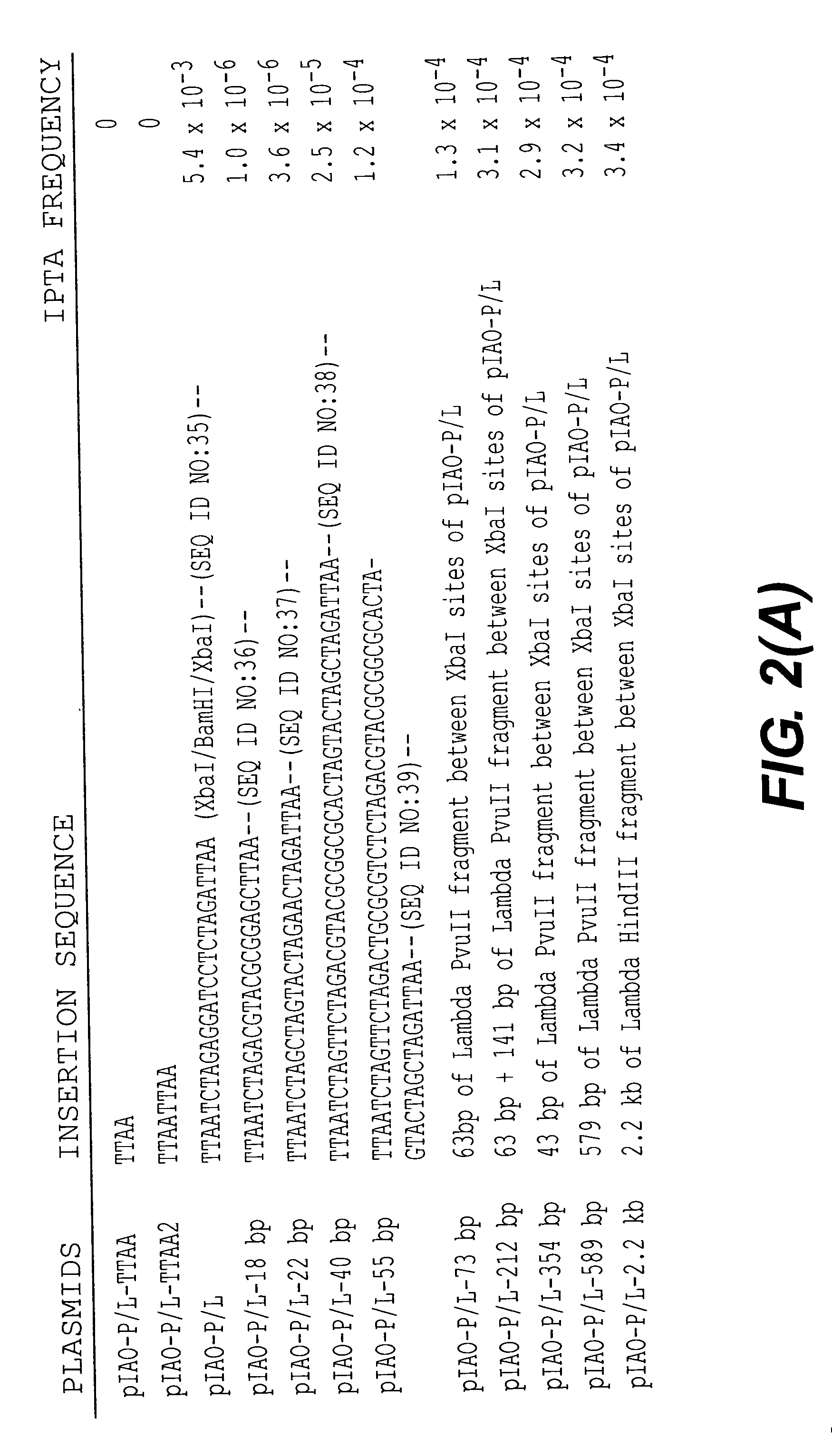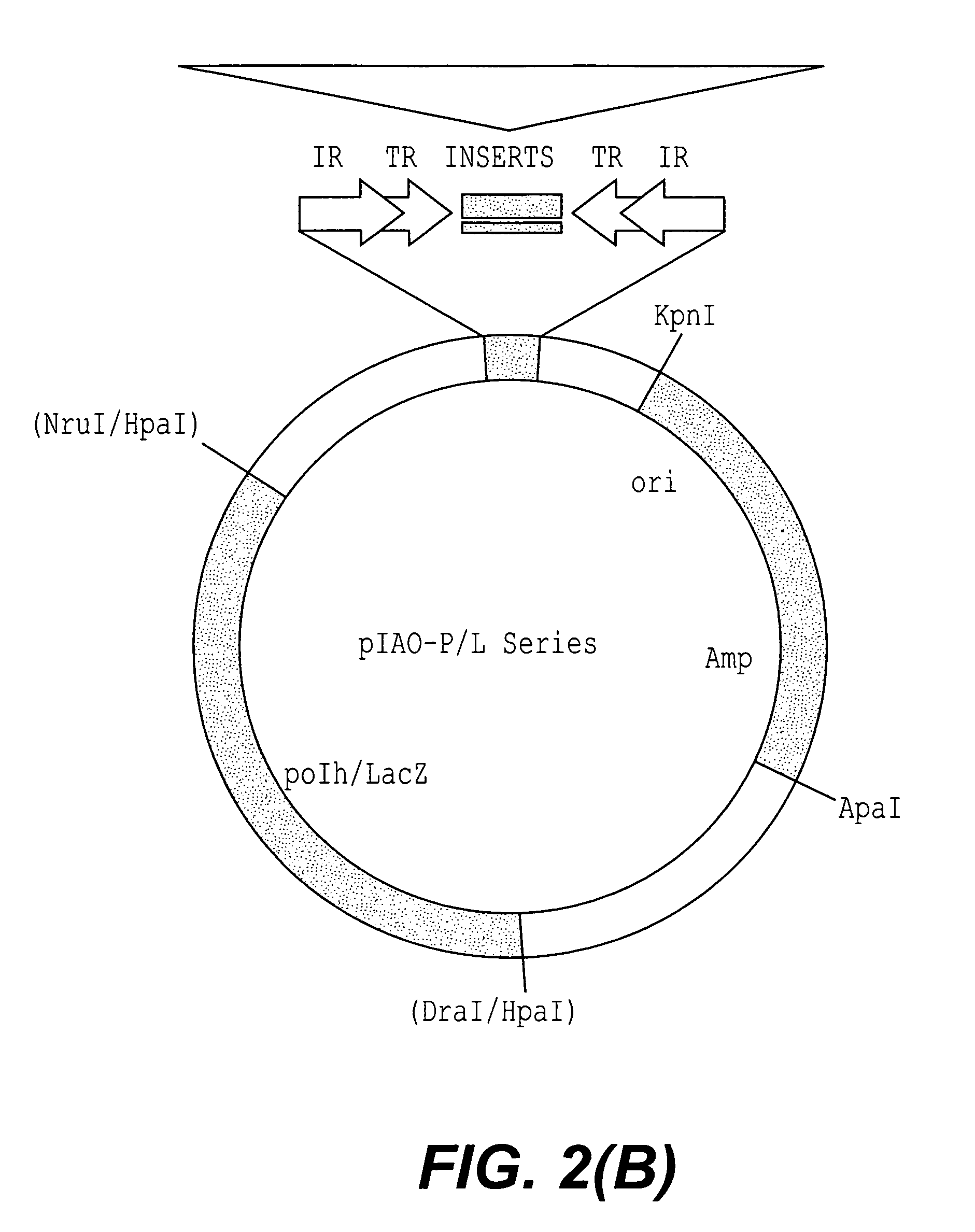Methods and compositions for transposition using minimal segments of the eukaryotic transformation vector piggyBac
- Summary
- Abstract
- Description
- Claims
- Application Information
AI Technical Summary
Benefits of technology
Problems solved by technology
Method used
Image
Examples
example 1
Excision Assay of p3E1.2 Internal Deletion Series in T.ni
[0105]The analysis was begun using three plasmids having the most extensive internal deletions, p3E1.2-d-9, p3E1.2-d-8 and p3E1.2-d-7. Sequencing of these three plasmids revealed that p3E1.2-d-8 and p3E1.2-d-7 retained 163 by and 303 by of the 3′ terminal region, respectively, including the IR, 31 bp spacer, and TR sequence. The p3E1.2-d-9 deletion plasmid retained only 36 by of the 3′ terminal domain, including the 3′ TTAA target site, 3′ TR and a portion of the 31 by spacer, but lacked the 3′ IR sequence.
[0106]Embryos of T.ni were injected with combinations of each of the p3E1.2 deletion plasmids and the phspBac helper plasmid. Loss of piggyBac sequences from the deletion series plasmids renders the plasmids resistant to BsiWI and SphI digestion. Transformation of Hirt extract DNAs digested with BsiWI and SphI were compared with transformations employing equal amounts of uncut DNA as a control to determine the frequency of ...
example 2
Minimal Distance Required between Termini for Movement of a PiggyBac Transposon Construct
[0108]The interplasmid transposition assay was carried out essentially as previously described by Lobo et al. (1999), Thibault et al. (1999) and Sarkar et al. (1997a). Embryos were injected with a combination of 3 plasmids. The donor plasmid, pB(KOα), carried a piggyBac element marked with the kanamycin resistance gene, ColE1 origin of replication, and the lacZ gene. The transposase providing helper plasmid, pCaSpeR-pB-orf, expressed the full length of the piggyBac ORF under the control of the D. melangaster hsp70 promoter. The target B. subtilis plasmid, pGDV1, is incapable of replication in E. coli, and contains the chloramphenicol resistance gene. Upon transposition of the genetically tagged piggyBac element from pB(KOα) into the target plasmid pGDV1 with the help of the transposase provided by the helper pCaSpeR-pB-orf that expresses the piggyBac transposase protein from a minimal hsp70 prom...
example 3
Interplasmid Transposition Assay of pCRII-ITR and pBSII-ITR Plasmids
[0111]According to an embodiment of the present invention, the excision assay described herein shows that a minimum of 163 by of the 3′ terminal region and 125 by of the 5′ terminal region (from the restriction site SacI to the end of the element) may be used for excision, while the pIAO-P / L constructs showed that a minimal distance of 55 by between termini may be utilized to effect movement. These data suggested that the inclusion of intact left and right terminal and internal repeats and spacer domains would be sufficient for transposition.
[0112]The pCRII-ITR plasmid was constructed following PCR of the terminal domains from pIAO-P / L-589 using a single IR specific primer. A second construct pCRII-JFO3 / 04 was also prepared using two primers that annealed to the piggyBac 5′ and 3′ internal domains respectively, in case repeat proximate sequences were required.
[0113]The interplasmid transposition assay was performed ...
PUM
| Property | Measurement | Unit |
|---|---|---|
| Fraction | aaaaa | aaaaa |
| Fraction | aaaaa | aaaaa |
| Fraction | aaaaa | aaaaa |
Abstract
Description
Claims
Application Information
 Login to View More
Login to View More - R&D
- Intellectual Property
- Life Sciences
- Materials
- Tech Scout
- Unparalleled Data Quality
- Higher Quality Content
- 60% Fewer Hallucinations
Browse by: Latest US Patents, China's latest patents, Technical Efficacy Thesaurus, Application Domain, Technology Topic, Popular Technical Reports.
© 2025 PatSnap. All rights reserved.Legal|Privacy policy|Modern Slavery Act Transparency Statement|Sitemap|About US| Contact US: help@patsnap.com



